
Citation: Aiswarya B, et al. A Study on the Influence of the Personal Attributes and Commitment Levels of Employees – Indian Perspective. Psychol Pshycholgy Res Int J 2017, 2(4): 000131.
*Corresponding author: Aiswarya B, Loyola Institute of Business Administration, Loyola College, Nungambakkam, Chennai, India, Tel: 09445254704; Email: aiswarya.b@liba.edu
Employee commitment towards an organization, contribute to retaining valuable human assets. Organizational commitment is defined as either as an employee attitude that binds an employee to an organization. This study identified three dimensions of commitment namely affective, normative and continuance commitment. One of the biggest challenge IT sector faces is the high rate of turnover. The purpose of the study was to examine the relationship between the demographic profile of employee’s and organizational commitment. Descriptive statistics was used to study the significant difference among the demographic variables and the findings were recorded.
Keywords: Literature; Criteria; Perspective; Commitment
High turnover rates among information technology professionals have a negative influence on firms ‘ability to serve overseas clients effectively. When an employee leaves, an offshore IT firm must incur several kinds of costs to make up for his/her move. To begin with, the firm must incur a cost of hiring to find a suitable replacement. Once the new employee is hired, he/she cannot be expected to be as productive as his/her predecessor since he/she has not yet learnt the nuances of the job, nor is he/she informed about the offshore client specific relationships. Thus, there is an opportunity cost of losing an employee. Finally, in order to make the new hire more productive the firm may have to provide some combination of technical, domain and process oriented training, all of which are an expensive proposition. Not only that, but it also affects the efficiency of team members still with the firm. India is considered the global leader in the information technology (IT) outsourcing market NASSCOM 2015 wherein many Western firms engage with offshore IT service providers located in India to help develop and maintain their IT applications. Offshore outsourcing to India has been an attractive proposition for the Western client firms because it provides an opportunity to reduce costs, access a global pool of personnel and expertise, and leverage their talent and spur innovation. Empirically, there is growing evidence that a positive relationship exists between the deployment of these systems of HR practices and firm level outcomes. Recent meta-analytic treatments of the literature suggest a relationship between adoption of these systems of practices and organization level outcomes, including profitability, productivity, and turnover). However, our capacity to draw firm conclusions regarding the strength and nature of this relationship is limited in several important ways. First, there is considerable variability in the manner in which the HR system construct is conceptualized and measured. The ability to create organizational commitment among professionals in the IT workforce is one of the measurement of success for companies. If companies are not efficient in retaining skilled talent in Information Technology (IT), it is unlikely that the organization will prosper in business operations. Lack of commitment affects companies due to the high cost of retaining, training, and developing new professionals. The definition of organizational commitment that is adopted in this literature is that of Allen & Meyer which looks at commitment as three dimensional concepts which has an attitudinal aspect, a continuance aspect and a normative aspect. In behavioural sciences research, organizational commitment is found to be distinguishable from other commitment constructs, such as occupational commitment, job satisfaction, job involvement, career salience, turnover intention, work group attachment, and the Protestant Work Ethic. Traditionally, commitment research has focused on commitment to the organization as a whole, and emphasized the relationship between the affective component of commitment and turnover [1-22].
ObjectiveTo study the impact of the personal attributes on the various dimensions of the commitment level of the employees.
Significance of the StudyThe significance of this study is to demonstrate that how and how - much the demographic attributes are important and its influence on the employee commitment towards the organization. Organizational commitment focus on the individual level forces that bind an employee to his / her organization. It also provides an analytical frame work that links the two constructs, HR practices and its impact on the employee commitment in Indian software firms.
Frame Work of the LiteratureEmployee commitment has long been of interest to researchers and practitioners, and given the challenges of today's marketplace, it is of considerable interest to organizations that wish to remain competitive. Commitment is an important part of an employee's psychological state because employees who experience high organizational commitment tend to exhibit selected behaviors, such as extraordinary performance, increased productivity and interest in innovation [21]. Additionally, high organizational commitment reportedly contributes to greater retention of employees, thus maximizing the investment that companies make in human capital.
CommitmentGagne ́& Deci A positive outcome on the HRM practices can be achieved if the organization looks into satisfying basic needs of employees by creating a favorable work environment as it inflates autonomous motivation among the employees. As they get attached to the organization, will subsequently results in higher affective commitment towards organization to stay long and loyal. As leaving the organization means employees has to lose all the benefits acquired through the favorable work environment [23]. Commitment is widely seen as a psychological state that links employees to an organization by indicating that strongly committed employees are less likely to leave the organization. In 1984, Meyer and Allen developed a model to measure commitment that accord to previous researcher’s conceptualization of commitment. Affective commitment, continuance commitment, and normative commitment are the three measures of commitment. Affective commitment points the employee's emotional attachment and involvement in the organization. Continuance commitment refers to the loss an employee would have to face if chose to leave [24].
Losses such as beneficial work environment cost of leaving the organization and also problems in alternative employment. Normative commitment reflects values and beliefs taught to employees through socialization that to remain loyal and committed to the organization. Affective commitment is found to be directly proportional to organizational commitment with positive impact on behavior of employees [25]. It’s found that the HRM practices adopted by the organization with motive to develop skill and knowledge of the employees and provide a career path through training and development, internal promotion, employment security, makes employees committed to the organization. The researchers Ogillvie and Gaertner&Nollen When and employees feels stressed and dissatisfied due to his job will eventually end up with low organizational commitment and will increase employee turnover. However, some situations even if not stressed and feel happy, few employees would still want to leave the organization with aim to get better career advantage from various other sources. Stress factor that affect employee commitment is inversely proportional to level of commitment of an employee [26,27].
Organization commitment is essential as it affects the level of effort by organization for employee welfare, turnover and employee’s orientation towards an organization. From employer’s point of view, employees can be categorized as committed and uncommitted employees based on certain attributes like employee belief, behavior, participation and job satisfaction. Employee commitment is always willful and rational. Organizational cannot compel an employee to stay committed to the company neither hire consultants to trigger it and that every employee has the freedom to drawback form organizational commitment on the event of sensing that staying committed doesn't bring any benefit to oneself and organization. The measure on the extra hour’s employees work for an organization to classify them under employee with high level of organizational commitment is “more than nine to five” Kanter, Goulet and Frank. The other behaviors of employees that affect employee commitment are lower absenteeism rate, turnover and level of engagement by employee, leader-subordinate relation, and job satisfaction [28]. Organizational commitment is a powerful predictor of job satisfaction and turnover [29]. Organizations to a great extent are interested in making employees committed to the organization. As promoting organizational commitment has resulted in improvement in employee performance and decrease in employee turnover. In other words, organization commitment helps in forming a bond between employee and organization.
Mathieu &Zajac (1990) in their research on organizational commitment found that commitment was collection of attitudes and behaviors. Attitudinal commitment is mental outlook and belief of how an employee views his own career goal linking with organizational goals. Behavioral commitment is employees staying faithful to the organization no matter what happens. Study conducted by Allen& Meyer (1990) is the most effective study which states that organizational commitment consists of three components Affective commitment, Continuance commitment, normative commitment [24].
Affective CommitmentAffective commitment is emotional attachment with organizations because employees want to be part of the organization [30]. Affective commitment can be developed by giving chance for employees to get involved in decision making, providing key for information through open communication. When an employee behavior is identified as lower absenteeism rate, perform tasks will full involvement is sign of affective commitment. Employee with high level of affective commitment will prefer to be part of the organization Meyer and Allen Affective commitment benefits associated to greater job performance.
Continuance CommitmentContinuance commitment is defined as “the extents to which employees feel commitment to their organization when they consider the cost of leaving the organization”, in other words employees decide to stay with the organization because cost of leaving is high. Jaros, 2007, states that continuance commitment do not exist if the employees leave the organization and incurs the cost of leaving because he/she was not aware of it. The factors that influence continuance commitment among employee is when an employee's made huge tangible and intangible investment by employees and limited employment opportunities outside the organization [30,31].
Normative CommitmentNormative commitment is a moral obligation that he/she stays in organization for ethical reasons. Meyer& Allen Normative commitment is influenced by socialization process that takes place before and after entering the organization. Normative commitment reflects two dimension that is, indebted obligation to meet others expectations and to continue employment based on societal norms, and meeting valued outcomes. Organizations adapts various human resource practices and provide attractive job for their employees in order develop higher level of employee loyalty among the employees, since employees looks to maximize selfinterest [32]. It's been commonly debated in management, total quality management, operational science and service literatures that increase in the level of loyalty and job satisfaction among the employees will result in better revenue and productivity [33]. Profit and growth are directly proportional to customer loyalty. Customer loyalty is achieved through satisfaction. Whereas customer satisfaction in stimulated by perception the customer holds on the values they receive on services. Values are created when put together employee’s loyalty and satisfaction with productivity. These employees prefer working in teams with common desire with definite commitment to communication, managerial empowerment and willfully satisfying customer expectation and achieving results (Employee Satisfaction”, 2005). IT professionals are more loyal to technology, facilities and infrastructure they work with rather the organization they work. That is, IT employees prefer organization that has better tech features as it will help the employees to work at ease and also help to enhance their skills and knowledge to the current trend. Organizational commitment refers to an employee’s loyalty to the organization, willingness to exert effort on behalf of the organization, degree of goal and value congruency with the organization, and a desire to maintain membership [34].
The Indian IT IndustryIndia is the world's largest sourcing destination for the information technology (IT) industry, accounting for approximately 67 per cent of the US$ 124-130 billion market. The industry employs about 10 million workforces. More importantly, the industry has led the economic transformation of the country and altered the perception of India in the global economy. India's cost competitiveness in providing IT services, which is approximately 3-4 times cheaper than the US, continues to be the mainstay of its Unique Selling Proposition (USP) in the global sourcing market. However, India is also gaining prominence in terms of intellectual capital with several global IT firms setting up their innovation centers in India. The IT industry has also created significant demand in the Indian education sector, especially for engineering and computer science. The Indian IT and ITeS industry is divided into four major segments – IT services, Business Process Management (BPM), software products and engineering services, and hardware. The IT-BPM sector which is currently valued at US$ 143 billion is expected to grow at a Compound Annual Growth Rate (CAGR) of 8.3 per cent year-on-year to US$ 143 billion for 2015-16. The sector is expected to contribute 9.5 per cent of India’s Gross Domestic Product (GDP) and more than 45 per cent in total services export in 2015-16.
India's IT Market Size GrowingAccording to the industry body NASSCOM, the revenue from the software product segment currently stands at 2.2 billion USD and is expected to reach 10 billion USD by 2020. Assuring that the growth of Indian IT sector is well on track; industry lobby NASSCOM today said that the sector would nearly triple its revenues of $350 billion by 2025.
According to NASSCOM, the Indian IT sector has a chance to grow and expand significantly as the range of products and services requiring enabling of information technology widens. Also according to the report the next $100 billion would help add around two million jobs in the sector. "The industry is expected to grow at over 11 per cent to $225 billion in 2020 and 10 per cent-plus to $350 billion by 2025. About 1.2-2 million people will be added with the next $100 billion revenue," the report said. However the industry is facing number of roadblocks starting from geopolitical to regulatory issues which needs innovation and disruption.
The IT sector has been the fastest growing industry in India. TCS is the largest private IT sector employer in the country and it has employs around 2.7 lakh people and offers services in 44 countries and Chennai is one of the companys largest delivery locations, as on December 11, 2015 followed by Infosys, Wipro, HCL and Tech Mahindra (NASSCOM industry ranking 2014).The IT companies, which together employ nearly 400,000 people in Chennai of which TCS with over 65,000 employees, Infosys with 25000 employees, Wipro around 22000 employees, HCL with 24000 employees and Tech Mahindra with 12000 employees in Chennai.
Research MethodologyThe purpose of the study is to examine the relationship between demographic factors of the employee’s and the pertinent level of employee’s expression of commitment to the organization which is the dependent variable. This study was conducted among employees of IT sector in Chennai. A onetime self-administered survey was used in this project. The design followed in the study is he descriptive research design. Questionnaires were distributed to the employees. The purpose of the survey was clearly explained to the respondents. It was stressed that participation in the responses was purely voluntary and that all responses will be held confidential. The data was collected using the questionnaire. The questionnaire included the exhaustive list of demographic variables, statements for all the variables included for the study. All the statements that were adopted are already tested and validated statements with minor modifications. The inventory included the affective, normative and the continuance commitment.
SamplingAs the population size is very large, sampling technique has been applied to conduct this study. In this study, population refers to IT professionals in IT and ITES firms located in Chennai city.
Sample unit of this study consists of employees in IT industry in Chennai city. Therefore, convenience sample technique is adopted for selecting the sample units. Thousand questionnaires have been distributed among respondents but only 735 have been received after continuous follow-up. Among the collected questionnaires, only 598 filled questionnaires are taken into account for the research. Of which 500 were in a useable condition.
Selection CriteriaTo be eligible to participate in the survey, an employee had to satisfy the following conditions: Be employed as a full time permanent employee (contract and temporary workers were excluded). This selection criterion is significant, because research has shown that the commitment levels of permanent employee differ from those in contract/temporary positions. Be employed with the current organization for one year or more. This criterion is particularly relevant because commitment to an organization develops over time. In addition, the Meyer and Allen’s (1991) affective commitment scale is being used for the present research. Be employed in executive position (administrative and support staff were excluded). The term executive in India means individuals who are professionals in their respective fields. This criterion is again important because comprehension about an organizational level phenomenon is best obtained from executives/professionals employed in an organization.
Data AnalysisThe initial data analysis involves conducting the ANOVA. Analysis of variance also tests for differences between means. However rather than testing each pair separately. ANOVA considers the variation among the groups together. ANOVA compares the variance with in each group with the variance between the groups. The outcome of the analysis is a numerical value for the F statistic which is used to determine if the groups are significantly different. ANOVA was used to analyses the degree of organizational commitment based on all the demographic variables under study. To further elaborate the Duncan analysis is applied to demographic variables to study the relationship with employee commitment.
Demographic Segmentation and Employee Commitment Analysis of VarianceOne-way ANOVA test is conducted for the purpose of understanding the role of age, gender, caste, personal income, family income, working hours, education, and designation of the respondents and its influence on the Organizational commitment. As mentioned in the study earlier, commitment is classified into three categories as affective commitment, normative commitment and continuance commitment
From the table we can infer that the age of the employee does not significantly influence the commitment of the employee towards the organization. Individual employees do not differ in their type and level of commitment irrespective of their age. However, the results of the ANOVA table prove that gender does influence employee commitment namely the affective and normative commitment and is significantly influenced than the continuance commitment. The results of the test prove men and women differ in their nature of commitment towards the organization, as supported by several literatures. The underlying contributing reason is basically the nature of the individuals. Similarly, there is no relationship or influence of the caste of the employee on the organizational commitment. This variable was included in the study to test the nature of the commitment as influenced by the caste or the community of the employee. In this era of work environment with diversified work force and Gen y employees, not many are influenced by the caste of the employees.
Independent t Test: Independent t test has been conducted to study the difference in the level of commitment among the employees for the differing gender. The following table explains the difference between the two different genders.
From the above table we could infer that there is not a wide variation in the level of commitment among the employees of the varying gender but, still however there is slight difference which could be adjudged using the mean difference. The female employees show a higher mean values for the three types of commitment compared to men. The test reconfirms the fact that women support and show a higher level of commitment towards their work place with sense of gratitude and loyalty.
The personal Income and the family income of the employees however has influenced significantly the employee commitment towards the organization. Affective and Normative commitment is the one affected by the personal and family income of the employees than the continuance commitment. The reason behind the noncompliance of continuance commitment may be the present nature of the employees are manifesting only professional commitment than the organizational commitment no matter which organization, the employees focus only on the career and profession.
Duncan analysis has been done to study the difference between sets of personal income. It has been identified that employees with less than rupees 20,000 income fall in one category and 21,000 – 40,000 and 41,000 – 60,000 fall in the second category for all the three types of commitment from the above outcome of the analysis we can infer that commitment differs among the employees with different levels of income.
The above table shows that commitment level differs with the level of family income. Employees with less than rupees 50,000 fall in a single category whereas as the level of family income increased all the employees fall in another category for all the two types of commitment.
ontinuance commitment show up different pattern of employees with lowest and highest salary falls in separate classes. The in-between classes do not show much significant difference and share both the categories.
The marital status as a demographic variable is observed to be the most important factor affecting the employee’s organization commitment all the three types of commitment namely, affective, normative and continuance commitment seems to be significantly influenced by the marital status of the employees.
The designation of the employee which places him/her in the hierarchy do not affect the commitment level towards the organization. The employee’s designation does not influences any of the three commitment levels.
The educational qualification of the employee is another important factor that influences the commitment of the employee. ANOVA test proves that there is high significant difference and high F value. It also indicates that all the three types of commitment are being affected by the educational qualification of the employee.
From the above table we could infer that there is difference in the level of commitment between the unmarried and the married employees. From the mean difference it is understood that the married employees have higher level of commitment than the unmarried employees for all the three types of commitment.
In affective, normative and continuance commitment the school educated has the highest level of education show a difference with the graduates and the post graduates, who fall within the same category. This shows that the attitude of the employees in terms of commitment vary with the level of education.
The working hours of the employee in the organization does not have any significant impact on the employee’s commitment. The results of the ANOVA interpret that neither increase nor decrease in the working hours will affect the employee commitment. Similarly, the test results on the varied number of years of experiences in this particular organization. It is observed that affective commitment is not influenced by the experience of the employee, whereas normative and continuance commitment is affected by the experience of the employee.
In analyzing the total experience and experience in the same organization of an employee, it is observed that affective and normative commitment is nuanced by the employee commitment, continuance commitment is unaffected by the employee commitment.
FindingsFrom the analysis the following findings are summarized.
Analysis of variance has been conducted to study the association of the demographic variables like age, marital status, caste, experience, education and income has upon the commitment of the employee. The age of the employee does not have any effect on the organizational commitment as irrespective of the age. Employees show commitment or not show commitment towards the organization, which cannot be categorized based on their age. Therefore, the HR policies will have to concentrate on all the age groups towards incorporating employee commitment. The gender of the employee is got a significant difference in the affective and normative commitment, which can be studied from the analysis of variance. On application of the t- test it was found out that female employee has higher level of commitment than their male counterparts. The employees from different castes show no significant difference in their level of commitment. The community to which the employee belongs does not influence the commitment towards his organization. The policies of the organization need not focus on the community and the caste to which the employee belong to. The personal income of the employees is found to have a significant difference in their level of commitment towards the organization. However, it is evident from the study that only the affective and the normative commitment is influenced by the income of the employee. The continuance commitment remains unaffected. On application of the Duncan analysis the higher income groups are closely associated in their level of commitment, than their lower income groups. Their commitment is also found to be slightly higher than their lower income groups. The family income significantly differs in the levels of commitment towards their organization. Specifically speaking the affective and the normative commitment is influenced by the family income. Similar to the personal income the lowest income category is different from all the other higher income groups. The level of commitment is almost the same for the high family income groups when compared to the lowest family income groups. The marital status of an employee does have a significant influence on the commitment of the employee towards the organization. All the three types of commitment are influenced by the employee’s marital status. It is clear from the study that married employees have a higher level of commitment towards the organization than the unmarried employees in the three aspects of the commitment. The designation of the employee does not influence his/ her commitment towards the organization. There is no significant difference among the different levels of designation. Whereas the education level of the employee has significant difference among themselves in their level of commitment towards the organization. It has been analyzed from the study that the graduates and post graduates fall in the same category and do not show much difference in their commitment. The school graduated fall in another category and differ significantly with the higher education groups. The same is common for all the three types of commitment. The working hours of the employee and her experience in one particular organization do not have any influence upon the commitment of the employee. Irrespective of the working hours and experience there may be other factors which are actually influencing the commitment rather than the study variables, namely the working hours and experience in the organization. In contrast the total experiences of the employee not only in this organization or in one particular organization do have significant difference in their level of commitment. Employees differ in the affective and normative commitment with respect to their total experience. The continuance commitment remains unaffected with the total experience. On analysis it is found that there is overlapping of the commitment among the different years of total experience. However, the lowest number of years specifically less than three years is found to fall in a separate category.
Recommendations from the StudyThe male gender employees must be more concentrated through the HR policies like incentives and keeping them satisfied and happy then the female employees are being naturally committed to the employer.
The HR policies of the organization need not focus much on the background namely community during the recruitment process, as the individual do not differ in their commitment level based on the caste or the community. In a country like Indian where there exist a number of castes and community based religion the outcome of the study proved that the behavior and attitudes of the employees do not differ or vary depending on the caste they belong to.
The employees of the lower income groups are found to slightly lack commitment, which may be contributed by their financial status. If their financial conditions and the comfort ability of living is taken care of by the employer may be the loyalty of employee towards the organization may be expected to increase.
The income of the individual when supported by the family may be through spouse or parents shows the satisfaction in the work place, which is reflected in the commitment of the employee towards the organization. We could infer that the financial stability of the family is the major factor that contributes to the commitment otherwise the employee will seek alternative employer who will in a position to meet his needs.
The unmarried employees do not have to have a compulsion necessarily to stick to the same employer, until otherwise some other variable is influencing him to stay. The HR policy must be carefully designed to suit the bachelors in the organization which will interest then and also drive commitment. The less educated category of the employees is found to lack commitment. It may be suggested that a regular training program, motivation or loyalty program may be organized to bring in a sense of commitment among the employees towards their employer.
ConclusionA satisfied and committed workforce leads to increased productivity due to fewer disruptions. When employees are committed, this enhances more stable attitudes toward their organization, and ultimately to greater acceptance of the goals of the organization, as well as greater willingness to exert more effort on behalf of the organization.HR practitioners must also play a proactive role in IT industry. Profitability and sustainability of company in long run cannot be ensured without focusing on HR management practices.
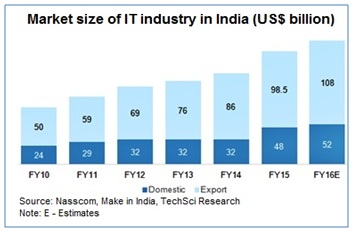
Figure 1: IT Industry in India.

Table 1: Age, Gender and Caste.
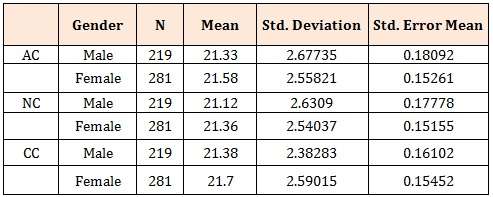
Table 2: Independent test Gender Wise.

Table 3: Personal Income and Family Income.
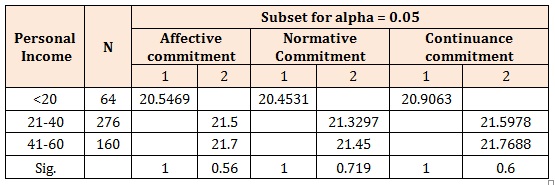
Table 4: Duncan Analysis for personal income.
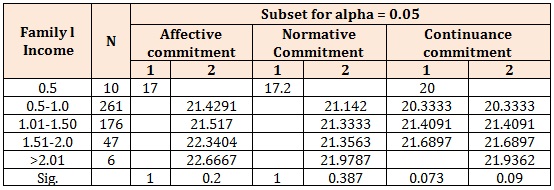
Table 5: Duncan analysis for Family income.

Table 6: ANOVA for Marital Status, Designation and Education.
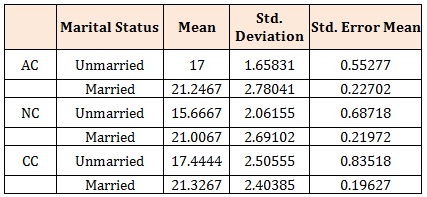
Table 7: Independent t test.

Table 8: Duncan analysis for education category.

Table 9: Working Hours, Experience in this Organization and Total Experience.
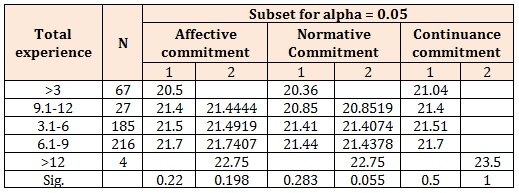
Table 10: Duncan analysis for Total experience.